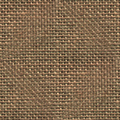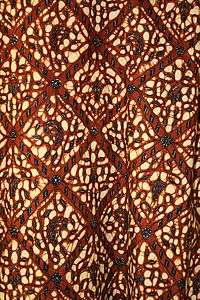Jamdani
| Part of a series on the |
| Culture of Bangladesh |
|---|
|
Rice Bread Fish Sweets Snacks Sauce |
| Religion |
|
Architects Painters Sculptor |
|
Literature History Genres Institutions Awards Writers |
|
Music and performing arts |
|
Monuments |
|
Jamdani (Bengali: জামদানি) is one of the finest muslin textiles of Bengal, produced in Dhaka District, Bangladesh for centuries.
The historic production of jamdani was patronized by imperial warrants of the Mughal emperors. Under British colonialism, the Bengali jamdani and muslin industries rapidly declined due to colonial import policies favoring industrially manufactured textiles. In more recent years, the production of jamdani has witnessed a revival in Bangladesh.
The traditional art of weaving jamdani has been declared by UNESCO as a Intangible Cultural Heritage of Humanity.[1][2][3]
Etymology
Jamdani was originally known as Dhakai named after the city of Dhaka, one of many ancient textile weaving centers in Bengal region.[4] Under the Mughal Empire the Persian term Jamdani came to be in popular use, since it was the court language of the Mughals. The term Jamdani is Persian deriving from 'Jam', meaning flower, and 'Dani', a vase or a container, named after decorative floral patterns found on Dhakai textile. Jamdanis are popularly known as Dhakai Jamdani or simply Dhakai. The earliest mention of jamdani and its development as an industry is found into Dhaka, Bangladesh.
Origin
The origin of the Jamdani is shrouded in mystery. The word Jamdani is of Persian origin; Jam meaning flower and Dani meaning a vase. The earliest mention of origin of Jamdani and its development as an industry is found in Kautilya's Arthashastra (book of economics, about 3rd century BC), where it is stated that this fine cloth was used in Bangla and Pundra. Its mention is also found in the book of Periplus of the Eritean Sea and in the accounts of Arab, Chinese and Italian travelers and traders.
Jamdani is a hand loom woven fabric made of cotton, which historically was referred to as muslin. Jamdani weaving tradition is of Bengali origin. It is one of the most time and labor-intensive forms of hand loom weaving. It is undoubtedly one of the varieties of finest muslin. It has been spoken of as the most artistic textile of the Bangladeshi weaver. Traditionally woven around Dhaka and created on the loom brocade, jamdani is fabulously rich in motifs.
History
The Jamdani weaving tradition is of Bengali origin. It is one of the most time and labor-intensive forms of hand loom weaving. In the first half of the nineteenth century, James Taylor described the figured or flowered jamdani; in the late nineteenth century, T. N. Mukharji referred to this fabric as jamdani muslin.
Weave
Whether figured or flowered, jamdani is a woven fabric in cotton, and it is undoubtedly one of the varieties of the finest muslin. It has been spoken of as the most artistic textile of the Bangladeshi weaver. They are traditionally woven around Dhaka, Bangladesh, and on the brocade loom. This is a supplementary weft technique of weaving, where the artistic motifs are produced by a non-structural weft, in addition to the standard weft that holds the warp threads together. The standard weft creates a fine, sheer fabric while the supplementary weft with thicker threads adds the intricate patterns to it. Each supplementary weft motif is added separately by hand by interlacing the weft threads into the warp with fine bamboo sticks using individual spools of thread. The result is a myriad of vibrant patterns that appear to float on a shimmering surface. What’s remarkable in this weaving technique is that the pattern is not sketched or outlined on the fabric. Instead, it is drawn on a graph paper and placed underneath the warp. Jamdani is a fine muslin cloth on which decorative motifs are woven on the loom, typically in grey and white. Often a mixture of cotton and gold thread were/was used.
Varieties of jamdani work
Though mostly used for saris, Jamdani is also used for scarves and handkerchiefs. Jamdani is believed to be a fusion of the ancient cloth-making techniques of Bengal (perhaps 2,000 years old) with the muslins produced by Bengali Muslims since the 14th century. Jamdani is the most expensive product of Dhaka looms since it requires the most lengthy and dedicated work.
Jamdani patterns are mostly of geometric, plant, and floral designs and are said to have originated thousands of years ago. Due to the exquisite painstaking methodology required, only aristocrats and royal families were able to afford such luxuries.
Changes with time
We do not know exactly when jamdani came to be adorned with floral patterns of the loom. It is, however, certain that in the Mughal period, most likely during the reign of either Emperor Akbar (1556–1605) or Emperor Jahangir (1605–1627), the figured or flowered muslin came to be known as the jamdani. Forbes Watson in his most valuable work titled Textile Manufactures and Costumes of the people of India holds that the figured muslins, because of their complicated designs, were always considered the most expensive productions of the Dhaka looms.[5]
Decline and fall
From the middle of the 19th century, there was a gradual decline in the jamdani industry. A number of factors contributed to this decline. The subsequent import of lower quality, but cheaper yarn from Europe, started the decline. Most importantly, the decline of Mughal power in India, deprived the producers of jamdani of their most influential patrons. Villages like Madhurapur and Jangalbari, (both in the Kishoreganj district), once famous for the jamdani industry went into gradual oblivion..
Current problems

According to a national daily, a senior taanti or "ostad" earns about Tk 2,500 to Tk 3,000 per month. Junior weavers get much less, around Tk 1,600. As a result, many weavers do not want their children to come to this profession. For many, the garments industry offer a lucrative alternative.

Thankfully, the government and other organizations are trying to revive the old glory of Dhakai Jamdani. In a bid to avoid the middlemen, they are trying to establish direct contact with the weavers. A Jamdani Palli has been established near Dhaka. Jamdani, one of the oldest forms of cottage industry in Bangladesh, was once a dying trade. Organizations like Radiant Institute of Design, Shanto Mariam University of creative technology,National Institute of Design (NID) and others are helping designers create new Jamdani designs.
Jamdani has never gone out of style. Even today, Jamdani is equally valued It has and it always will symbolize aristocracy. The demand for quality Jamdani Sarees have increased exponentially over the years.
Controversy regarding Geographical Indication
Despite being a Bangladeshi tradition, India has filed a Geographical Indication for Jamdani in 2009. However Bangladesh felt that the GI should be granted to Bangladesh. Several protests continued in Bangladesh following it.[6][7]
References
- ↑ "jamdani". britannica.com. Retrieved 2013-12-04.
- ↑ "Jamdani recognised as intangible cultural heritage by Unesco". the daily star. Retrieved 2013-12-04.
- ↑ "Traditional art of Jamdani weaving". UNESCO Culture Sector. Retrieved 2013-12-04.
- ↑
- ↑ Glassie, Henry and Mahmud, Firoz.2008.Living Traditions. Cultural Survey of Bangladesh Series-II. Asiatic Society of Bangladesh. Dhaka. pp.351
- ↑ "Press reports on Protecting Geographical Indication Products in Bangladesh - Centre for Policy Dialogue (CPD)". Centre for Policy Dialogue (CPD). Retrieved 2015-11-24.
- ↑ "India – Bangladesh Parliamentary Dialogue". www.ficci-inbdpd.com. Retrieved 2015-11-24.


.svg.png)